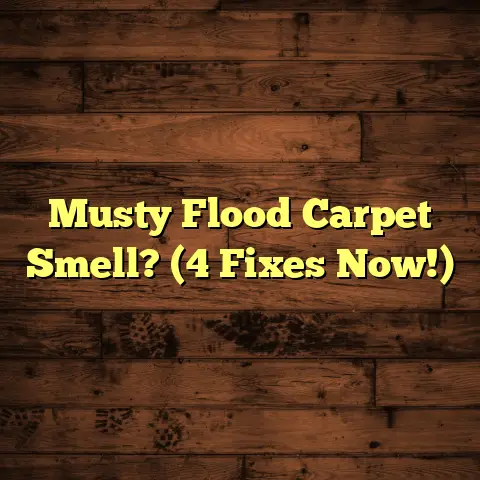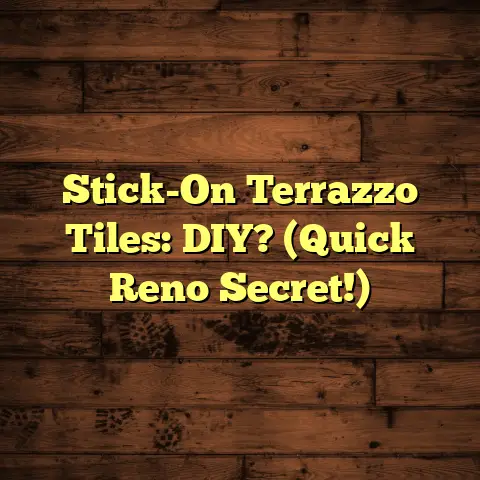Keep Floors Dry & Clean: Pro Tips (2 Secrets!)
As a flooring contractor with years under my belt, I’ve seen it all – from pristine, gleaming floors to those that have clearly seen better days (and probably a few too many spills!).
I’m here to share some insider knowledge to help you keep your floors looking their best.
Think of this as a friendly chat about the importance of dry and clean floors, and how to achieve that.
We’ll dive into some seasonal considerations, and I’ll let you in on two secrets that can make a world of difference.
Introduction: Tapping into Seasonal Trends
Ever notice how your floors seem to suffer more during certain times of the year?
It’s not your imagination!
Each season brings its own set of challenges.
Spring brings rain and mud, winter brings snow and salt, and summer brings humidity and sand.
These seasonal shifts can wreak havoc on your flooring if you’re not prepared.
Imagine tracking in muddy footprints after a spring shower, or dealing with the sticky residue from melted snow in the winter.
Not fun, right?
Adapting your cleaning and maintenance routines to these seasonal trends is crucial.
What works in the dry heat of summer might not be effective during the dampness of spring.
That’s why it’s important to have a strategy.
Keeping your floors dry and clean isn’t just about aesthetics; it’s about protecting your investment and maintaining a healthy home.
Think of it this way: your floors are the foundation of your home’s appearance and comfort.
Taking care of them is essential.
So, what are the secrets to achieving this?
Well, I’m about to reveal them!
The first secret is all about effective cleaning techniques, and the second focuses on preventative measures to keep floors dry.
Ready to learn more? Let’s dive in!
Section 1: Understanding the Importance of Dry and Clean Floors
Why is it so important to keep your floors dry and clean, anyway?
Beyond the obvious aesthetic benefits, there are some serious health and safety implications to consider.
Let’s start with the health aspect.
Dirty or wet floors can be breeding grounds for bacteria, mold, and allergens.
Think about it: your floors are constantly exposed to dirt, dust, and other contaminants that can be tracked in from outside.
When these contaminants accumulate, they can trigger allergies, asthma, and other respiratory problems.
Mold growth, in particular, can be a major health hazard.
According to the EPA, mold can cause a variety of health problems, including nasal stuffiness, throat irritation, coughing or wheezing, eye irritation, and skin irritation.
And let’s not forget about slip hazards.
Wet floors are a leading cause of falls, especially for young children and older adults.
According to the CDC, falls are the leading cause of injury and death from injury among older Americans.
Keeping your floors dry is essential for preventing these accidents.
But it’s not just about health and safety.
Clean floors also contribute to the overall ambiance of your home or workspace.
Think about walking into a room with gleaming, spotless floors.
It instantly creates a sense of cleanliness, order, and comfort.
On the other hand, dirty or stained floors can make a space feel dingy, unwelcoming, and even depressing.
I’ve seen firsthand how clean floors can transform a space.
One of my clients, a small business owner, was struggling to attract customers to her store.
After I cleaned and polished her floors, she told me that she immediately saw an increase in foot traffic.
People were simply more drawn to the clean, inviting atmosphere.
Now, let’s talk about different flooring materials.
Each type of flooring requires specific care to maintain its appearance and durability.
-
Hardwood floors, for example, are beautiful and durable, but they’re also susceptible to water damage and scratches.
They require regular cleaning with a wood-specific cleaner and should be protected from excessive moisture. * Tile floors are generally more resistant to water damage, but they can still be stained by spills and require regular grout cleaning. * Carpet is great for adding warmth and comfort to a space, but it can also trap dirt, dust, and allergens.
It requires regular vacuuming and occasional deep cleaning. * Laminate floors are a budget-friendly option that are relatively easy to clean.
However, they can be damaged by excessive moisture and harsh chemicals.
Choosing the right cleaning products and techniques for your specific flooring type is essential for maintaining its appearance and longevity.
Here’s a statistic to drive home the point: According to a study by the American Cleaning Institute, regular cleaning can extend the life of your flooring by up to 50%.
That’s a significant return on investment!
So, as you can see, keeping your floors dry and clean is about more than just aesthetics.
It’s about protecting your health, preventing accidents, and extending the life of your flooring.
Now that we’ve established the importance of dry and clean floors, let’s move on to the first secret: effective cleaning techniques.
Section 2: Secret 1 – Effective Cleaning Techniques
Alright, let’s get down to the nitty-gritty: how to actually clean your floors effectively.
This is where my first secret comes into play.
It’s not just about grabbing a mop and sloshing some water around.
It’s about understanding the right techniques, tools, and products for your specific flooring type.
I’ve broken this down into three subsections: daily maintenance routines, deep cleaning strategies, and seasonal deep cleaning.
Subsection 1.1: Daily Maintenance Routines
Daily maintenance is the foundation of clean floors.
Think of it as brushing your teeth – you do it every day to prevent bigger problems down the road.
For most flooring types, a daily sweeping or vacuuming is essential.
This removes loose dirt, dust, and debris that can scratch or damage your floors over time.
-
For hardwood floors, I recommend using a soft-bristled broom or a vacuum cleaner with a hardwood floor attachment.
Avoid using vacuums with beater bars, as these can scratch the surface. * For tile floors, you can use a broom or a vacuum cleaner with a hard floor attachment.
Pay special attention to the grout lines, as they can easily accumulate dirt and grime. * For carpet, regular vacuuming is crucial.
I recommend vacuuming high-traffic areas at least twice a week, and the entire carpet at least once a week.
Use a vacuum cleaner with a HEPA filter to trap allergens and dust mites. * For laminate floors, a soft-bristled broom or a vacuum cleaner with a hard floor attachment is ideal.
Avoid using excessive water when cleaning laminate, as it can seep into the seams and cause damage.
In addition to sweeping or vacuuming, spot cleaning is also important.
If you spill something on your floor, clean it up immediately to prevent stains and water damage.
Use a clean, damp cloth and a mild detergent.
Avoid using harsh chemicals, as these can damage your flooring.
Microfiber mops are a game-changer when it comes to daily maintenance.
They’re incredibly effective at picking up dirt and dust, and they’re gentle on all types of floors.
I recommend using a microfiber mop with a reusable pad.
This is not only more environmentally friendly, but it’s also more cost-effective in the long run.
Here’s a quick checklist for daily maintenance:
- Sweep or vacuum all floors.
- Spot clean any spills or stains.
- Use a microfiber mop to remove any remaining dirt or dust.
By following these simple daily maintenance routines, you can keep your floors looking their best and prevent the buildup of dirt and grime.
Subsection 1.2: Deep Cleaning Strategies
While daily maintenance is important, it’s not enough to keep your floors truly clean.
Every now and then, you need to give them a good deep cleaning.
Deep cleaning involves using more intensive cleaning methods to remove stubborn dirt, stains, and grime.
The frequency of deep cleaning depends on your lifestyle and the type of flooring you have.
In general, I recommend deep cleaning your floors at least once a season, or more often if you have pets or young children.
Here’s a step-by-step process for deep cleaning various flooring types:
-
Hardwood floors:
- Start by sweeping or vacuuming the floor to remove any loose dirt or debris.
- Prepare a cleaning solution by mixing a small amount of wood-specific cleaner with water, following the manufacturer’s instructions.
- Dampen a microfiber mop with the cleaning solution.
- Wring out the mop thoroughly to prevent excessive moisture.
- Mop the floor in the direction of the wood grain.
- Rinse the mop frequently and wring it out thoroughly.
- Allow the floor to air dry completely.
-
Tile floors:
-
Sweep or vacuum the floor to remove any loose dirt or debris.
- Prepare a cleaning solution by mixing a tile-specific cleaner with water, following the manufacturer’s instructions.
- Apply the cleaning solution to the floor using a mop or sponge.
- Let the solution sit for a few minutes to loosen any dirt or grime.
- Scrub the grout lines with a grout brush.
- Rinse the floor thoroughly with clean water.
- Allow the floor to air dry completely.
-
Carpet:
-
Vacuum the carpet thoroughly to remove any loose dirt or debris.
- Pre-treat any stains with a carpet stain remover.
- Use a carpet cleaner or a steam cleaner to deep clean the carpet.
- Follow the manufacturer’s instructions for the carpet cleaner or steam cleaner.
- Allow the carpet to dry completely before walking on it.
-
Laminate floors:
-
Sweep or vacuum the floor to remove any loose dirt or debris.
- Prepare a cleaning solution by mixing a laminate-specific cleaner with water, following the manufacturer’s instructions.
- Dampen a microfiber mop with the cleaning solution.
- Wring out the mop thoroughly to prevent excessive moisture.
- Mop the floor in the direction of the planks.
- Rinse the mop frequently and wring it out thoroughly.
- Allow the floor to air dry completely.
When it comes to deep cleaning, it’s important to avoid using harsh chemicals that could damage your floors.
I’m a big fan of using natural cleaning solutions whenever possible.
For example, you can use a mixture of vinegar and water to clean tile floors, or baking soda to remove stains from carpets.
Here are a few tips for using natural cleaning solutions:
-
Vinegar: Mix equal parts vinegar and water in a spray bottle.
Spray the solution on the floor and wipe with a clean cloth. * Baking soda: Sprinkle baking soda on the stain and let it sit for a few minutes.
Vacuum up the baking soda. * Lemon juice: Mix lemon juice with water in a spray bottle.
Spray the solution on the floor and wipe with a clean cloth.
Always test any cleaning solution in an inconspicuous area before applying it to the entire floor.
This will help you ensure that it doesn’t damage the finish.
Subsection 1.3: Seasonal Deep Cleaning
As I mentioned earlier, different seasons bring different challenges when it comes to floor care.
That’s why it’s important to schedule seasonal deep cleanings to address specific issues.
Here’s a seasonal deep cleaning schedule that I recommend:
-
Spring: After the rainy season, deep clean your floors to remove any mud, dirt, and grime that has accumulated.
Pay special attention to entryways and high-traffic areas. * Summer: After summer vacations and outdoor activities, deep clean your floors to remove any sand, dirt, and sunscreen residue.
Focus on areas that are exposed to direct sunlight, as these can fade over time. * Fall: Before the holidays, deep clean your floors to prepare for guests.
Pay special attention to dining areas and living rooms. * Winter: After the holidays, deep clean your floors to remove any salt, snow, and dirt that has been tracked in from outside.
Focus on entryways and areas near fireplaces.
During seasonal deep cleanings, it’s important to use specialized products for different flooring materials.
For example, you might want to use a sealant for wood floors to protect them from moisture, or a pH-neutral cleaner for tiles to prevent damage to the grout.
Here are a few tips for using specialized products:
- Read the manufacturer’s instructions carefully.
- Test the product in an inconspicuous area before applying it to the entire floor.
- Use the product sparingly.
- Rinse the floor thoroughly after using the product.
By following a seasonal deep cleaning schedule and using specialized products, you can keep your floors looking their best year-round.
Now that we’ve covered effective cleaning techniques, let’s move on to the second secret: preventative measures to keep floors dry.
Section 3: Secret 2 – Preventative Measures to Keep Floors Dry
Cleaning is essential, but it’s even better to prevent your floors from getting dirty and wet in the first place.
That’s where my second secret comes in: preventative measures.
By taking a few simple steps, you can significantly reduce the amount of dirt and moisture that ends up on your floors.
This will not only save you time and effort, but it will also extend the life of your flooring.
I’ve broken this down into four subsections: entryway management, humidity control, quick response to spills, and regular inspections.
Subsection 2.1: Entryway Management
Your entryway is the first line of defense against dirt and moisture.
By creating a clean entryway, you can minimize the amount of dirt that gets tracked onto your floors.
Here are a few tips for creating a clean entryway:
-
Install mats: Place mats both inside and outside your entryway.
These mats will trap dirt and moisture before they can reach your floors.
Choose mats that are made of durable, absorbent materials. * Encourage shoe removal: Ask guests to remove their shoes when they enter your home.
Provide a shoe rack or a bench where they can store their shoes.
This will significantly reduce the amount of dirt and debris that gets tracked onto your floors. * Provide shoe covers: If you don’t want to ask guests to remove their shoes, provide shoe covers that they can wear inside.
These shoe covers will protect your floors from dirt and moisture. * Clean the entryway regularly: Sweep or vacuum the entryway regularly to remove any dirt or debris that has accumulated.
Mop the entryway as needed to remove any stains or spills.
I’ve seen firsthand how effective entryway management can be.
One of my clients, a busy mom with three kids, was constantly struggling to keep her floors clean.
After I helped her create a clean entryway, she told me that she immediately noticed a difference.
Her floors were significantly cleaner, and she was spending less time cleaning.
Subsection 2.2: Humidity Control
Humidity can be a major problem for flooring, especially wood and laminate.
Excessive humidity can cause wood floors to warp, buckle, and crack.
It can also cause laminate floors to peel and blister.
Here are a few tips for controlling humidity in your home:
-
Use a dehumidifier: A dehumidifier can help remove excess moisture from the air.
Choose a dehumidifier that is the right size for your home. * Use proper ventilation: Make sure your home is properly ventilated.
Open windows and doors to allow fresh air to circulate.
Use exhaust fans in bathrooms and kitchens to remove moisture. * Use air conditioning: Air conditioning can help reduce humidity levels in your home.
Set your thermostat to a comfortable temperature and run the air conditioner regularly. * Fix any leaks: Repair any leaks in your plumbing or roof to prevent water damage and humidity buildup.
Check your pipes, faucets, and roof regularly for leaks.
I once had a client who lived in a humid climate and had beautiful hardwood floors.
Unfortunately, she wasn’t aware of the importance of humidity control.
Over time, her floors started to warp and buckle.
I had to replace the entire floor, which was a costly and time-consuming process.
Subsection 2.3: Quick Response to Spills
Spills are inevitable, but how you respond to them can make a big difference.
The longer a spill sits on your floor, the more likely it is to stain or cause water damage.
Here’s a checklist of materials to keep on hand for immediate cleanup:
- Clean cloths: Keep a supply of clean, absorbent cloths on hand.
- Paper towels: Paper towels are great for soaking up spills.
- Mild detergent: A mild detergent can help remove stains.
- Water: Water is essential for rinsing the floor after cleaning.
- Spray bottle: A spray bottle can be used to apply cleaning solutions.
Here are a few tips for cleaning up spills quickly and effectively:
- Act fast: The sooner you clean up the spill, the better.
- Blot, don’t rub: Blot the spill with a clean cloth or paper towel. Rubbing can spread the spill and make it harder to clean.
- Use the right cleaner: Use a cleaner that is appropriate for the type of spill and the type of flooring.
- Rinse thoroughly: Rinse the floor thoroughly with clean water after cleaning.
- Dry the floor: Dry the floor with a clean cloth or paper towel.
I’ve seen some pretty disastrous spills in my day.
One time, a client spilled an entire bottle of red wine on her white carpet.
She panicked and started rubbing the stain, which only made it worse.
I was able to remove the stain with a specialized carpet cleaner, but it took a lot of time and effort.
Subsection 2.4: Regular Inspections
Regular inspections are essential for identifying potential problems before they become major issues.
By inspecting your floors regularly, you can catch minor damage, such as scratches or stains, and address them before they worsen.
Here’s a simple checklist for homeowners to evaluate their floors monthly:
- Check for scratches: Look for any scratches or gouges in the flooring.
- Check for stains: Look for any stains or discoloration.
- Check for water damage: Look for any signs of water damage, such as warping, buckling, or discoloration.
- Check for loose tiles or planks: Look for any loose tiles or planks.
- Check the grout: Look for any cracks or crumbling in the grout.
If you find any problems during your inspection, address them promptly.
Repair any scratches or gouges, clean any stains, and fix any water damage.
Replace any loose tiles or planks, and repair any cracks or crumbling in the grout.
I had a client who regularly inspected her floors and caught a small leak under her kitchen sink.
She was able to repair the leak before it caused any major water damage to her floors.
By following these preventative measures, you can keep your floors dry and clean and extend their lifespan.
Conclusion: Reinforcing the Importance of Dry and Clean Floors
So, there you have it – my pro tips for keeping your floors dry and clean!
We’ve covered a lot of ground, from understanding the importance of dry and clean floors to implementing effective cleaning techniques and preventative measures.
Remember, maintaining dry and clean floors is about more than just aesthetics.
It’s about protecting your health, preventing accidents, and extending the life of your flooring.
By implementing the two secrets I’ve shared – effective cleaning techniques and preventative measures – you can create a healthy, safe, and beautiful home.
Don’t underestimate the power of daily maintenance.
A quick sweep or vacuum can go a long way in preventing the buildup of dirt and grime.
And don’t forget to schedule seasonal deep cleanings to address specific issues that arise during different times of the year.
By being proactive in your flooring maintenance efforts, you can avoid costly repairs and replacements down the road.
Investing time and effort into floor care will yield lasting benefits for your home and health.
Call to Action
Now, I want to hear from you!
What are your favorite tips and tricks for keeping your floors dry and clean?
Share your experiences and insights in the comments section below.
Let’s create a community of shared learning and help each other keep our floors looking their best!





